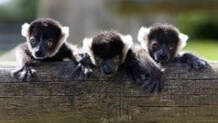
These lemurs exist only in Madagascar’s declining eastern tropical rainforests. The main threat to their survival is humans. Because they are large compared to other lemur species, poachers and village men hunt them as bushmeat. In addition, slash-and-burn agriculture, logging, and mining threaten their habitat. In the last thirty years, their population has decreased by 80%.
Although classified as frugivores, feeding on fruits, they also eat a variety of seeds, leaves and nectar. These lemurs are arboreal, living in trees. They eat and sleep in trees. They are quite the acrobats, leaping from branch to branch and hanging by their feet.
Two Reasons They’re Classified As Pollinators.
First, they are seed dispersers. With all the fruit they eat, they excrete the seeds later onto the forest floor, which makes them especially important in the regeneration of trees.
Second, they are unique in their relationship with the traveler’s tree or palm. The tree itself is interesting. The paddle-shaped leaves are in a fan-shape. When it rains, the water flows down these leaves into the base of the tree, which is hollow. Interestingly, the leaves of this tree are used to treat diabetes, stomach aches, and dizziness.
For two to three months of the year while the Traveler’s Palms are in flower, lemurs will travel between plants and stick their long snout into the flower to feed and cost their nose with pollen. The lemurs have the strength to open the flower heads to access the nectar, which has a sucrose content twice as high as honey. The seeds of the Traveler’s Palm are a bright Lapis Lazuli blue.

Black-and-white lemurs have the second loudest call of all primates! From barks to howls, they have 12 different calls. It seems the howls are in defense of territory, and the barks are alarms.
Females are dominant. They can give birth to up to six infants in nests in trees and can nurse them all simultaneously. The infants are left in the nest while the female forages. Since the infants are incapable of clinging to the backs of the mother, she must move them one at a time when they are young. Although 65% of infants fail to reach three months of age, they become independent at four months and are mature at 20 months.
Interesting Facts
- Groups of lemurs have been called a congress of lemurs and a conspiracy of lemurs.
- A lemur was an ancient Roman ghost, thought to be a wandering spirit. The animal lemurs were mistaken for specters because of their nocturnal, stealth habits. When people first heard their loud calls, they thought they came from ghosts in the forest.
- Ruffed lemurs are quadrupedal, using all their limbs for locomotion. Their long tails allow for even better stability in the trees. In fact, most hang upside down, holding on by their feet, when feeding!
- This species of lemur are the only primates to make a nest for their offspring.
- Lemurs have special scent glands on their wrists and bottoms that leave scent trails on branches to mark their territories.
- These lemurs use their bottom teeth, their "toothcomb," for social bonding through grooming.
- Once there were lemurs as large as a female gorilla.
- Black-and-white ruffed lemurs are the only primates which have true litters of young.
- They love to sunbathe while lying on their backs, their arms outstretched.
Conclusion
Although they have found that the lemurs thrive in captivity, they do not adapt well into the wild. Therefore, it is important that the threats to their existence be addressed. They are an important contributor to the maintenance of one of the world’s rainforests.
 RSS Feed
RSS Feed

